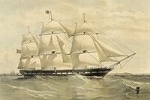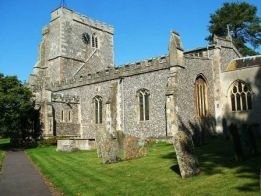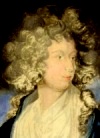This is the 2009 Introduction to the stories about the Calland and Hawkins families involved. The deeds of our house show that the land was sold in 1873 by the Hawkins family. The sale of The Field estate and its subsequent Victorian development is described in its own section of this website, when local research started up again in 2010.
The essays describe the Calland and Hawkins families, and what they got up to. Inevitably, the stories include a lot of biographical detail; if this slows the story down I have moved it to separate drill-down pages from the main story pages. The links on the left take you to the individual chapters, which I describe below.
Once upon a time ....

Chapter 1 - Madras, 1750 John CALLAND left Gosport at the age of 16 and made a huge fortune with the East India Company in Madras. Journey times were long, and many passengers and sailors had unwanted adventures. John was sent home after a corruption enquiry but with his money intact, a wife who was the daughter of the Governor of Fort St George, and a baby daughter Sarah. He settled in London and looked for a good solicitor to help him start investing his money.

Chapter 2 - Westminster, 1770 Samuel HAWKINS was a successful Westminster lawyer who fell in love with Sarah CALLAND. After an elopment and two weddings they lived in Pall Mall and had ten children. Many of them went to India, two sons went into the Church of England, and one of those sons inherited the land in Stroud. Samuel made a fortune, founded a bank, lost it all, but Sarah had enough for them to move to France, from where they sent many letters. They were married for over fifty years.

Chapter 3 - Back in England, 1780 The CALLAND sons went to Westminster school, John was a generous man and a terrible judge of character. From a schoolfriend in difficulties, Samuel found the Welsh coalfield which would support the Calland and Hawkins families for ever. The Calland children prospered though some were scoundrels. The family was usually taking someone to court, and left huge wills containing stern instructions. Drill down to genealogy-level notes for Callands 1635 - 1750, and 1750 - 1900 and to the dramatic newspaper report of the attack on Charles Calland.

Chapter 4 - Wiltshire, 1815 After a childhood in France, an MA at Oxford, and ordination at Salisbury, Samuel and Sarah HAWKINS's son John Cunningham Calland Bennett Popkin HAWKINS (JCCBPH) became Vicar of Holy Cross church, Ramsbury. He and his wife Elizabeth GREGORY had thirteen children but very little cash. None of his sons stayed close but his seven unmarried daughters did, and when he died they became homeless. I found them in Kent. Drill down to stories about the HAWKINS sons, and life in a Victorian vicarage.

Chapter 5 - Stroud, 1873 Serendipity at last. Having started with a list of names, I now had a much bigger list of names, many of them connected. But not all. Then, in the county archives in Oxford, we found the crucial papers that link the Arundel, Gregory and Hawkins families. Now I know who had owned the land, how they got it, why they sold it, and who had bought it. But it had taken a long time to join everyone up and find out where to look.
Our house deeds - Saved from the shredder
Once a house has been recorded on the central electronic Land Register for England, the earlier papers which had proved entitlement to ownership – the Title Deeds – are no longer legally binding and can be what the Land Registry euphemistically calls ‘dematerialised’. Everyone with any interest in family or local history was horrified when this news broke at the start of 2009. Given a tiny bit of small and obscure print in the mortgage agreement and without any further notice, mortgage-providers were quietly shredding or pulping unique original papers, full of real signatures and margin notes and plans and lists of interested parties long dead. Some mortgage-providers did return the deeds to the owners, others just had not got round to clearing their dusty cupboards. I was very fortunate. Ours were in a dusty cupboard and I got them back, just in time.
For nearly thirty years now, our family has lived in Stroud, though John and I were both born in Yorkshire and have written extensively about that elsewhere on this website. We first moved to a big Georgian house on the outskirts of town which has its own history. Later we moved across town to a large mid-Victorian semi-detached of the familiar kind, built before cars were invented, so there are few driveways and parking is always a problem.
Deed of Mutual Covenant
Before the houses were built, the land was farmland and a few old quarries immediately to the east of Stroud town. The land was inexplicably sold by a huge list of people, including a couple of local bigwigs and ten people all with the surname HAWKINS. These names appeared in the Deed of Mutual Covenant (a general agreement about rights of way and fences and some trades and nuisances that would not be acceptable) which was the first of our Title Deeds. Also named in that Deed of Mutual Covenant were the first thirty-two buyers of some of the building lots. All this information could have been shredded and gone forever. I have put a transcript of the full document here.
I knew it would be interesting to trace the people, and to find out who these HAWKINSes were, and how they became involved. After six months’ research and a bit of obsession, I was able to put the story together. It was not helped by the fact that the then local vicar was called Hawkins, but he had come from Ireland. There were other Hawkins families in Stroud and also Paul Hawkins Fisher, a 19thC solicitor. They were a dead-end; occupied days of searching and comparing and resulted in nothing. There are many strands, with unexpected twists and knots and tangles, so I have divided the story into chronological chapters.
Useful links and bibliography
Specific sources are listed with the separate essays, but without the following resources I would not have been able to start:- The newspaper extracts came from the invaluable Gale academic website, which can be accessed through some English county libraries' online options. Make a fuss if your county does not offer a link to the whole database, which contains a digitised and searchable 10% of the British Library's collection of 17th, 18th and 19th century newspapers, and The Times. If you are really stuck, and have a UK address, you can join the Lancashire county library service on-line and for free, and get access that way.
- Another comprehensive source is British History Online, which aims to make obscure and key documents freely available. Organised geographically, and easily searchable, you can spend days just reading.
- The County Archive in Cowley, Oxford, has one of the best on-line catalogues I have seen, with detailed descriptions of individual documents. I am most grateful to the County Archivist for his permission to quote from the many documents we found there.
- The Hawkins family biographies, and the letters and diaries of the Revd Bradford Denne Hawkins, are on the Rivenhall (Essex) website's Village History - People section. Many of the Revd David Nash's transcripts are here, and I am extremely grateful for his readiness, in his retirement, to share the papers he holds.
- Census information is held by the National Archives and made available through many subscription services; we use Ancestry. The Calland and Hawkins wills are also stored at the National Archives, where pdf copies are available for a very modest sum.
- The Church of England provides a useful on-line database searchable by person or place.


